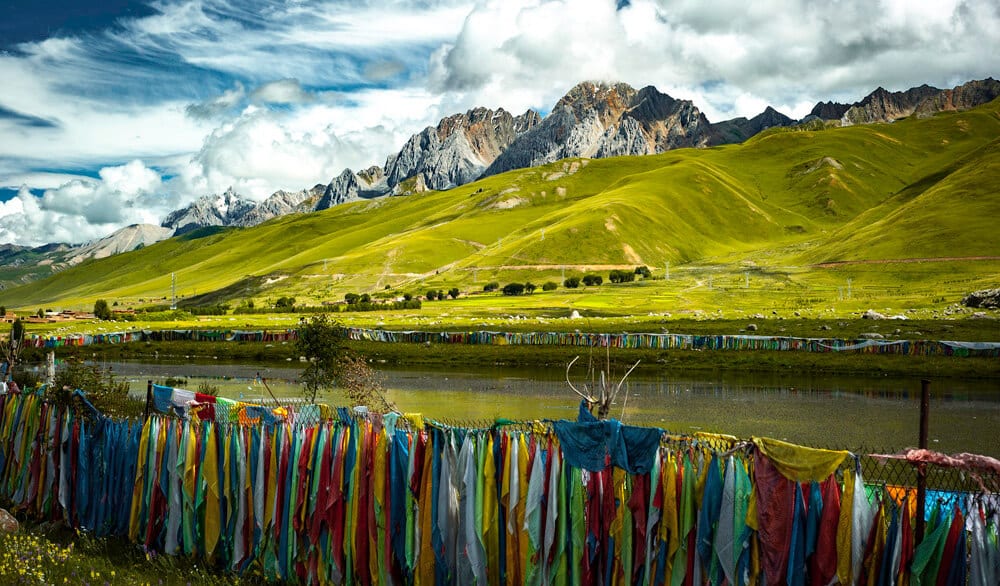Journey to the Sacred Land of Tibet
Relaxing Into the Spaciousness of the Land
When traveling across the Tibetan Plateau the line between tourist and pilgrim naturally fades. Here, we are not referring to being a pilgrim in a religious sense. We are speaking of something much larger. When standing in the middle of a vast, endless landscape where you feel so tiny and so small the tight grip of relating to ourselves as such and such naturally loses its importance – it is such a relief! You can allow yourself to let go and to merge your mind with that spaciousness that is so naturally available in this vast Himalayan region. The endless and vast Tibetan Plateau
The endless and vast Tibetan Plateau
Tibet, From Seabed to the ‘Roof of the World’
We are traveling across the Tibetan Plateau – the highest altitude desert in the world – and it’s slowly getting easier for our bodies and lungs to catch up with the decrease of oxygen available up here on these high plains. Some 1 million years ago Tibet used to be covered by seawater and today it is popularly referred to as ‘roof of the world’, literally a roof as it forms the highest landscape of our planet.  Farmer on the Tibetan Plateau
Farmer on the Tibetan Plateau
The Earth-bound Groundedness of the People of the Land
The sky is as blue as can be and the air feels crisp and thin. Up here, you feel so far away from the speediness of the world we know from back home. Up here, it is as if you have more direct access to your heart and to the natural clarity of mind, in spite of the physical hardship of the high altitude.
When we encounter the local people, they smile at us with their big smiles and greet us heartily on our way. There is a certain distinct groundedness in the Tibetan people we meet across the plateau, an ‘earth-like’ quality of being so in tuned with the surrounding land that is so mighty and so vast. I have experienced this similar sense of connection between the land and the people living there when traveling in Australia with the Aboriginal people or with the native people of Central America. It calms down my nervous system so much being amidst ‘people of the land’ and it makes me realise just how much we have lost touch with this sense of ‘being’ in our busy and urban lives.  Monks at the Tashilungpo Monastery in Shigatse, Tibet
Monks at the Tashilungpo Monastery in Shigatse, Tibet
The ‘Other-Wordly’ and Mysterious Tibet
When traveling across Tibet we pass incredible monasteries, temples and sacred pilgrimage sites in breathtaking high altitude scenery. That mysterious and ‘other worldly’ component that Tibet is so often associated with in literature and in art we are suddenly able to fully grasp.
One of my favourite spots in all of Tibet is the Jorkhang in Lhasa. The Jorkhang is the spiritual heart of Lhasa and is surrounded by the old, Tibetan neighbourhood of the Barkhor. Once you have found your way to the Jorkhang, through the small and narrow streets of Barkhor, you suddenly find yourself joining the stream of Tibetans – pilgrims as well as people just getting off work – as they circumambulate the sacred temple of the Jowo.
Then you know that you have landed right in the middle of one of the most sacred and most amazing places of our planet. The Potala Palace, home to the Dalai Lama
The Potala Palace, home to the Dalai Lama
Lhasa, the land of Gods
Jowo (the word Jorkhang – house of the Jowo) refers to the sacred Buddha Shakyamuni statue that was gifted to Lhasa by the Chinese wife of the great 8thcentury king, Songtsen Gampo. Songtsen Gampo is said to be the first Dharma king of Tibet and was pivotal in unifying Tibet as we know it today and to have introduced Buddhism as the national religion with the help of his friend Guru Rinpoche (also referred to as Padmasambhava – the ‘Lotus Born’). Lhasa was made capital city of Tibet in the 8thcentury and during the reign of Songtsen Gampo many of the most sacred temples of Lhasa and Tibet were built, including the foundation of what we today know as the Potala Palace, home to the Dalai Lamas since the 5thDalai Lama.
Whispers of prayers, especially the Om Mani Padme Hung mantra, the smell of butterlamps lit as offering to the Jowo, the sound of wooden blocks hitting the ground as people prostrate around the sacred temple all constitute the atmosphere here. It is an ‘other worldly’ fairy-tale, yet not in a far off land, but right here in our world.  The Gyantse Kumbum, one of the most spectacular Stupas of Tibet
The Gyantse Kumbum, one of the most spectacular Stupas of Tibet












































